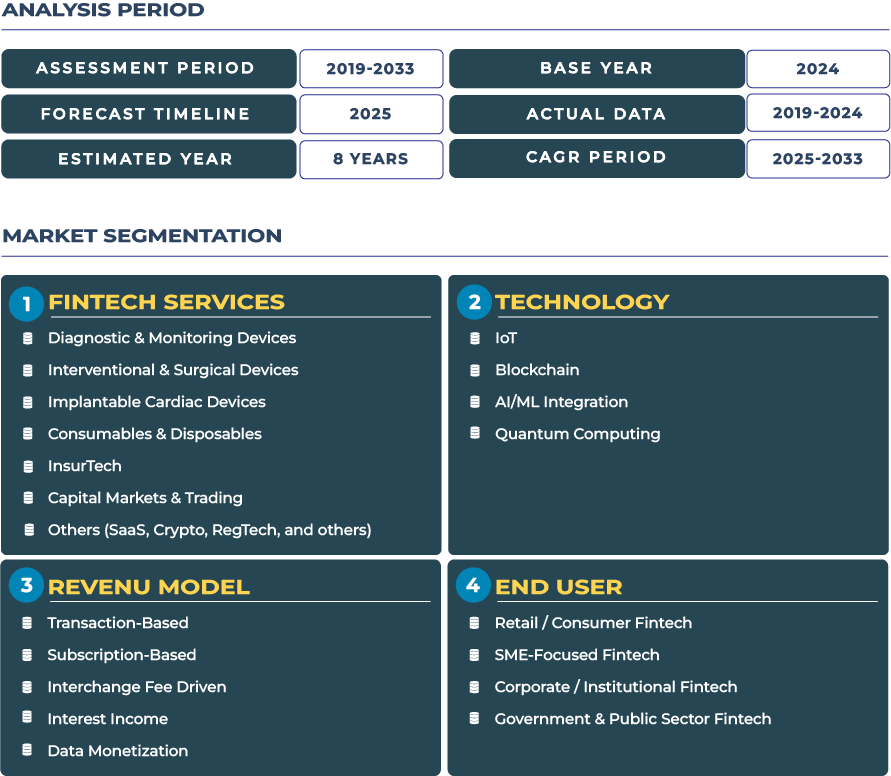India Fintech Market Outlook: UPI as the Anchor for Credit, Insurance & Cross-Border Expansion
India has emerged as a global laboratory for digital financial innovation, where the Unified Payments Interface UPI powers domestic inclusion and increasingly serves as a blueprint for global digital public infrastructure exports. More than just a payments rail, UPI is now the anchor for innovations in micro-credit, insurance premium collection, and cross-border payment corridors. The India Fintech Market is projected to expand from USD 6.3 billion in 2025 to USD 18.3 billion by 2033, registering a CAGR of 14.3%. This trajectory reflects not only domestic adoption but also India’s growing influence in setting global standards for financial interoperability.
Interlinkages between UPI and credit/insurance services demonstrate how a single interoperable framework can scale across sub-segments of the fintech ecosystem. Micro-lending, micro-insurance, and rural financial inclusion are increasingly powered by UPI-linked systems. In parallel, India’s push to export UPI as a cross-border settlement model is positioning the country as a leader in digital public goods, a theme recognized by global financial bodies and foreign governments.
UPI-Led Financial Infrastructure Driving Inclusive and Scalable Growth
The Indian fintech sector continues to demonstrate resilience, adaptability, and expansion potential. At its core lies UPI, which crossed 12 billion transactions in a single month by mid-2024, reflecting consumer trust in real-time, low-cost digital payments. As UPI evolves, it is increasingly linked to value-added services such as credit-on-tap, merchant financing, and insurance distribution. This evolution strengthens the case for UPI as the backbone of India’s financial architecture.
Beyond urban adoption, UPI penetration in semi-urban and rural regions is opening fresh growth avenues. Financial services, once considered inaccessible, are now reaching small merchants, farmers, and low-income households through QR-based payments and simplified user interfaces. The rise of India’s fintech market also coincides with geopolitical realignments where the export of digital public infrastructure like UPI is discussed in multilateral platforms. This strengthens India’s position as a digital finance exporter, while domestic markets benefit from global credibility and investment confidence.
Looking forward, India’s fintech market will consolidate its role as both an inclusion enabler and a global digital finance reference model, setting the pace for other emerging economies.
Drivers & Restraints: Expanding Financial Access and Regulatory Complexity Defining the Growth Curve
Expanding drivers of growth: India’s fintech industry is propelled by its vast underbanked population, numbering over 190 million adults without access to formal banking as of 2024, according to the Reserve Bank of India. Fintech solutions bridge this gap by leveraging Aadhaar-enabled digital identity, mobile penetration, and UPI interoperability. For instance, micro-credit models linked to UPI are enabling instant disbursals for merchants, while insurance premiums collected through digital wallets are making protection more affordable. The sheer scale of India’s population creates a compounding effect on adoption, ensuring exponential growth potential for fintech services.
Restraining forces: Despite progress, the Indian fintech landscape is not without challenges. Price-sensitive consumers often expect zero-cost financial services, placing downward pressure on margins for fintechs. Additionally, complex state-level regulations and differences in licensing requirements across financial sub-segments create friction for scaling operations nationally. For instance, lending tech platforms face compliance-heavy onboarding processes, while insurtech firms must navigate varied state-level distribution norms. These frictions slow the pace of innovation and add compliance costs, particularly for startups seeking to expand aggressively.
Thus, while inclusion and digital infrastructure serve as strong growth catalysts, regulatory complexity and consumer price sensitivity remain pressing hurdles in India’s fintech journey.
Trends & Opportunities: UPI-Enabled Ecosystem Unlocking New Horizons in Lending, Insurance, and Digital Assets
Key trends shaping the landscape: The dominance of UPI has triggered a wave of secondary innovations. Real-time merchant financing, UPI-linked credit lines, and insurance premium auto-debits are transforming financial behavior. In metro cities like Bengaluru and Mumbai, neo-banks targeting millennials are scaling through digital-only models, offering customized investment and wealth management tools integrated into payments apps. Meanwhile, Tier-2 and Tier-3 cities are witnessing mass adoption of QR-based payments, enabling small businesses to integrate seamlessly into formal finance.
Emerging opportunities: Micro-lending and micro-insurance remain significant white spaces. Rural India, where financial penetration is still low, offers opportunities for UPI-linked products bundled with Aadhaar-enabled verification. Digital gold investments, already popular in regions like Kerala and Maharashtra, are being integrated into mobile platforms, enabling low-income groups to diversify assets. Moreover, India’s role in exporting UPI to markets in Southeast Asia and the Middle East opens fresh corridors for cross-border remittances, strengthening its fintech positioning globally.
Government Regulation: Progressive Policies Enabling Innovation While Strengthening Oversight
India fintech growth has been underpinned by proactive policy measures and regulatory innovation. The Ministry of Electronics and Information Technology has supported the development of digital public infrastructure, while the Securities and Exchange Board of India continues to refine frameworks for wealthtech and digital trading platforms. Regulatory sandboxes initiated by Reserve Bank of India have allowed fintech companies to test innovative solutions under controlled environments, accelerating the rollout of new products without exposing consumers to systemic risks.
At the same time, regulators are tightening norms on data privacy, consumer protection, and lending practices. For instance, stricter Know Your Customer (KYC) requirements have been introduced to prevent misuse of digital platforms. Such measures aim to strike a balance between enabling innovation and ensuring financial stability within the India fintech ecosystem.
Key Impacting Factors: Digital Transaction Volumes and Licensing Frameworks Redefining Market Performance
India fintech market performance is significantly influenced by the scale of UPI transaction volumes and the evolution of licensing frameworks for digital banks. UPI transactions exceeded USD 2 trillion equivalent in FY 2024, a landmark achievement that cements India’s role as a leader in digital finance. This growth fuels fintech-led innovations in merchant services, lending, and insurance distribution. At the same time, the issuance of new digital bank licenses—currently under discussion at regulatory levels—could redefine competitive dynamics by providing fintechs with broader access to deposits and lending channels.
Additionally, geopolitical and economic factors such as inflationary pressures and global supply chain disruptions influence consumer spending patterns, indirectly impacting fintech adoption rates. While macro risks persist, India’s fintech sector remains anchored by strong digital infrastructure and government-backed support systems.
Competitive Landscape: Strategic Partnerships and Product Innovations Defining the Next Growth Wave
The Indian fintech industry is characterized by dynamic competition and rapid innovation. In September 2025, Paytm launched a UPI credit line product, branded as “Paytm Postpaid,” in collaboration with Suryoday Small Finance Bank. This partnership reflects how fintech companies are leveraging UPI ubiquity to scale credit products while banks provide underwriting and compliance expertise.
Other leading players are pursuing similar strategies. PhonePe has integrated wealth management services into its app, while BharatPe continues to expand merchant-focused lending and acceptance solutions. International entrants are also exploring India’s fintech landscape, attracted by the country’s large consumer base and interoperable digital rails. These developments highlight how fintech firms are combining partnerships, product innovation, and regulatory collaboration to consolidate leadership within India’s fast-evolving financial ecosystem.
Conclusion: India’s Fintech Ecosystem as a Global Blueprint for Inclusive Digital Finance
India fintech story is one of scale, innovation, and global influence. By leveraging UPI as the anchor, the nation has successfully built a financial ecosystem that transcends payments to include lending, insurance, wealth management, and cross-border corridors. The blend of digital public infrastructure, strong regulatory oversight, and entrepreneurial innovation has created a sustainable foundation for future growth.
The future of India fintech market lies in its ability to balance inclusion with profitability, while exporting its proven models to other emerging economies. Rural expansion, micro-credit bundling, and insurance penetration will be key drivers, while international collaborations on UPI corridors will reinforce India’s reputation as a fintech innovator. Ultimately, India’s fintech sector will remain central to the country economic modernization, serving as both a domestic inclusion engine and a global benchmark for digital finance.







